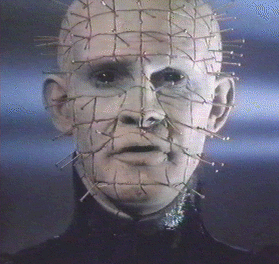 Hellraiser: Killing For
Kicks
Hellraiser: Killing For
Kicks Hellraiser: Killing For
Kicks
Hellraiser: Killing For
KicksClive Barker promised to tear your soul apart, and he did. His nightmarish creation Pinhead and his backing Cenobites took the horror world by storm in 1987 when they were featured prominently in the trailers and posters for one of the creepiest and strangest horror movies of all time: Hellraiser.
Based on his earlier novella "The Hellbound Heart," Barker brings us the story of Frank Cotton, a man whose appetite for experience leads him to all kinds of depravity… until the Lemarrzad Box (henceforth called the Lament Configuration) crosses his path. It summons the Cenobites, explorers in the realm of human experience. To them, pain and pleasure are indivisible and Frank becomes their latest acquisition. Torn apart by hook-tipped chains, part of his spirit still lives on in the upstairs attic of an old Victorian house.
Now his brother Rory and his new wife Julia have come to claim the house as their own. Julia still carries a torch for Frank, who seduced (perhaps "raped" is a better word) her the day of her wedding to Rory. Their marriage appears to be a loveless one, both resigned to making the best of things in their new home.
That is, until Rory cuts open his hand while moving a mattress and his
blood brings Frank back to a crusty form of life. Frank’s resurrection
is one of the more eye-opening scenes filmed in horror cinema… provided
that you’re not watching it from behind your hands, that is. The thing is, Frank’s return to the land
of the living is mostly incomplete. Specifically, he lacks flesh and skin.
Julia to the rescue. She lures men back to her house with the promise of
an afternoon fling and instead bludgeons their skulls with a hammer until
they’re suitable for Frank to feed off of.
from behind your hands, that is. The thing is, Frank’s return to the land
of the living is mostly incomplete. Specifically, he lacks flesh and skin.
Julia to the rescue. She lures men back to her house with the promise of
an afternoon fling and instead bludgeons their skulls with a hammer until
they’re suitable for Frank to feed off of.
Meanwhile Rory’s daughter Kirsty is distrustful of her new stepmother, but determined to put the best face on things for her father’s sake. Until she discovers Julia is leading men back to the house. Until she discovers Frank’s skinless countenance upstairs, calling to her incestuously: "Come… come to Uncle Frank." And until she discovers the Lament Configuration, which she throws out the window after Frank pleads for it back.
It’s at this point that both of their days take a major downhill turn, because a) Frank has just lost his safety net against the Cenobites and b) Kirsty ends up opening the box. The Cenobites come and, unlike the horror movie B-queens who scream their heads off at the sight of a monster, Kirsty keeps her cool and makes a deal. Her soul in exchange for Frank’s. The Cenobites agree, but warn her against any sort of treachery with the promise of eternal anguish. Plus, Frank has to give himself away. Not an easy assignment.
Kirsty flees back to her fathers’ house, but she is too late. Frank and Julia have murdered Rory and given his skin to Frank. Kirsty is almost about to be carved up by Frank when he whispers to her, "Don’t worry, it’s only Frank… it’s only Uncle Frank."
Big mistake. The Cenobites hear his admission and come for him. Frank is torn apart by the chains (one of the more gut-wrenching sequences done in the history of film) and Kirsty flees the house. So ends Hellraiser.
By combining sex and death, writer/director Barker takes the standard
movie genres and turns them on their ears. A murderous woman obsessed with
a dead man? The trading of skins? Franks’ desire for Kirsty? These are
areas that the brilliant and brutal Barker never flinches away from. Filmed
for a shockingly low $2 million in England, Hellraiser still hits chords a decade later that can’t be denied. Avoid the sequels (except for
Hellbound: Hellraiser II) and discover the world of the Cenobites.
chords a decade later that can’t be denied. Avoid the sequels (except for
Hellbound: Hellraiser II) and discover the world of the Cenobites.
But be sure to bring an extra skin.